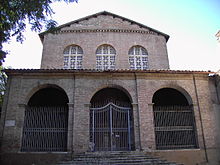Santa Balbina
| Santa Balbina Saint Balbina (English) Sancti Balbinæ (Latin) |
|
|---|---|

The façade of Santa Balbina
|
|
| Basic information | |
| Location |
|
| Affiliation | Roman Catholic |
| District | Lazio |
| Province | Rome |
| Ecclesiastical or organizational status | Titular church |
| Leadership | Péter Erdo |
| Architectural description | |
| Architectural type | Church |
| Groundbreaking | 4th Century |
Santa Balbina is a basilica church in Rome, devoted to St. Balbina. It was built in the 4th century over the house of consul Lucius Fabius Cilo on the Aventine Hill, behind the Baths of Caracalla. Possibly the ancient Titulus Tigridae, the basilica was consecrated by Pope Gregory I.
The adjoining monastery has a commanding medieval defence tower. Inside the basilica there is a very fine episcopal chair with Cosmatesque decoration from the 13th century. The church was heavily restored in the 1930s when frescoes were discovered on the side walls from the 9th to 14th centuries. The Baroque frescoes in the apse and the triumphal arch were painted by Anastasio Fontebuoni in 1599. The triumphal arch is decorated with the figures of Ss Paul and Peter while in the apse we can see St Balbina between other martyrs.
An ancient sarcophagus was also discovered during the restoration. It is now used as a font.
In 1270 the first known Hungarian cardinal, István Váncsa was buried in the basilica. Another 13th century Hungarian clergyman, Pál, Bishop of Paphos, erected an altar in the church for Saint Nicolas. Both the altar and the grave disappeared during later centuries but a plaque commemorates the offerings of Pál.
The Cardinal Priest of the Titulus S. Balbinae is Péter Erdő, Archbishop of Esztergom. According to Péter Erdő the Hungarian connections of the church played part in the Pope's decision when he chose Santa Balbina as Erdő's titular church. The Cardinal also recommended Hungarian pilgrims to visit the basilica and said he feels a special responsibility for the building. Among the previous titulars, Alfonso de la Cueva, marqués de Bedmar and Francisco Jiménez de Cisneros.
...
Wikipedia
